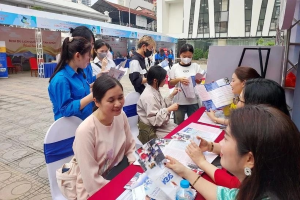
Hanoi deals with human resources shortage in tourism industry
Latest
The capital city welcomed about 14.05 million visitors with a shortage in human resources, including 3.14 million foreigners in the first six months of this year, respective rises of 13.7 per cent and 52.6 per cent year on year.
 |
| At a festival providing information to students and parents about human resources training in the fields of culture, sports and tourism. (Source: VNA) |
Total earnings from tourism activities were estimated at 55.38 trillion VND (2.17 billion USD), up 22.8 per cent year on year. The city has introduced many new tourism products, including night tours in Thang Long Imperial Citadel, Hoa Lo Prison, Vietnam Literature Museum, Van Mieu-Quoc Tu Giam (Temple of Literature), and Ngoc Son Temple, as well as pedestrian spaces at Son Tay Ancient Citadel, Dao Ngoc-Ngu Xa, Tran Nhan Tong street, and several community-based tourism sites.
At the same time, the municipal Department of Tourism has strengthened cooperation with other localities in developing tours and routes such as the Hanoi - Ha Nam - Ninh Binh spiritual - cultural route, Hanoi - Son La, and Hanoi - Lao Cai - Lai Chau exploring tours.
However, the city has encountered difficulties in both quality and number of human resources for the sector, especially after the COVID-19 pandemic which drove a large number of tourism personnel to other sectors.
Experts noted that the COVID-19 pandemic has caused the hotel industry to lose about 20 - 30 per cent of its employees, putting it in a labor shortage situation.
Besides the shortage of specialized labor in the tourism industry, the tourism market is also facing a more important problem, which is a lack of development direction and vision of many tourism businesses, especially among small and micro enterprises.
Nhu Thi Ngan, General Director of Hanoi Tourism JSC pointed to the need for solutions to develop human resources in the new period, which she said requires the coordination of all stakeholders including State agencies, training facilities, businesses, experts, scientists, and laborers themselves.
Ngan underlined the need for State agencies to provide policy support to encourage laborers to return to the tourism sector in the post-pandemic period while calling for businesses’ engagement in human resources training activities.
She advised travel firms to consider on-the-job training and private training based on their demands and goals.
The Hanoi tourism sector has also made efforts to provide training to different workforces engaging in the industry, including drivers and those working at accommodation facilities and community-based tourism sites.
The Department of Tourism has organized many seminars on civilized tourism for local communities in major tourist sites in Soc Son, Me Linh, Thanh Tri, Thanh Oai, My Duc, and Thach That.
The director of the department Dang Huong Giang said that the department has designed many measures to attract high-quality personnel to the tourism industry such as linking with international organizations and foreign tourism training service providers, mobilizing resources for tourism human resources training, and strengthening cooperation among the State, training facilities and businesses.
Particularly, the city has worked to foster the coordination among local tourism training facilities, travel firms, and reputable international tourism training organizations, thus stepping by steps strengthening human resources provision for the industry, Giang added.

















